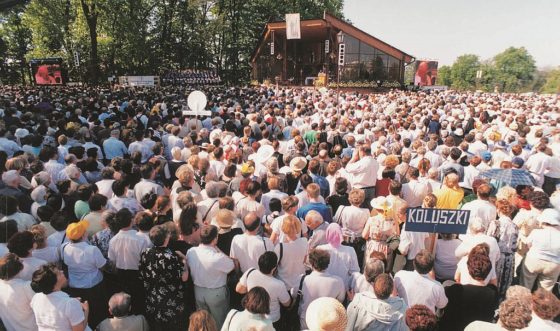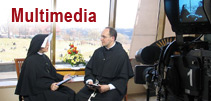In her ‘Diary’ Sister Faustina depicted the canonization ceremony many years before the event took place. Although she did not know the invention of the television or the telebridge – communication through a satellite – on the 23rd March, 1937, she had a vision during which she saw that the ceremony would take place in Rome and in Cracow simultaneously. Thanks to technological inventions, the participants in the canonization ceremony, which took place on the 30th April, 2000, were able to experience it at the same time whether they were in Rome or in Cracow. Therefore, her prophetic vision of the canonization ceremony in Rome and Cracow, as well as the prophecy that the Feast of Mercy would be instituted for the whole Church, were fulfilled. This is how Sister Faustina described the ceremony herself:
“
“Suddenly, the Divine presence inundated me and I saw myself in Rome, in the Holy Father’s chapel, while at the same time I was in our own chapel, and the ceremony celebrated by the Holy Father and the entire Church was closely connected with our chapel and, in a special way, with our Congregation; I was participating at the same time in the service held in Rome and in our chapel. Since our ceremony was so closely linked with Rome, I don’t exactly know how to distinguish [between the two ceremonies], but that’s what I saw and that’s what I’m writing. I saw Jesus exposed in a monstrance on the great altar in our chapel. The chapel was decorated for a feast day, and on this day it was open to everyone, anyone who wanted [to attend]. The crowds were so huge that I couldn’t see an end to them. They were all taking part in the ceremony with great joy, and many received what they had asked for. The same ceremony was being held in Rome in a beautiful church, and the Holy Father and all the clergy were celebrating it; and suddenly I saw St. Peter standing between the altar and the Holy Father. I couldn’t hear what St. Peter said, but I realised that the Holy Father understood him… (…)
Suddenly, I saw the two rays that are in the painting come out of the Sacred Host and go round the whole world. It happened in a flash but seemed to last a whole day, and on that day our chapel was overcrowded, and the entire day was full of joy.
And suddenly, I saw Jesus alive on our altar, the way He is in the painting. But I felt that none of the sisters nor the people could see Jesus as I see Him. Jesus looked with such graciousness and joy at the Holy Father, certain priests, and all the clergy, all the people, and our Congregation.
Suddenly, I was snatched up close to Jesus, and I stood on the altar next to Him. My spirit was filled with such great bliss that I can neither comprehend nor describe it in writing. A profound peace and serenity inundated my soul. Jesus turned to me and said graciously, “What do you wish for, My daughter?” And I replied, “I want Your mercy praised and glorified.” “I am already being praised through the institution and celebration of this Feast, is there anything else that you want?” I looked at the huge crowds praising Divine mercy and said to the Lord, “Jesus, bless all the people who have gathered to give praise to You, to Your infinite mercy.” Jesus made a sign of the cross with His hand to bless them; the blessing was reflected as a light shining on their souls. My spirit was immersed in His love; I felt as if I had melted and disappeared in God. When I came round, there was a profound peace flooding my soul, and my mind was granted an extraordinary understanding of many things that had been incomprehensible to me before” (Diary, 1044-1048).
VIDEOLINK
Sister Faustina’s prophecy pertaining to her canonization has been fulfilled. She wrote that the ceremony would take place simultaneously in Rome, with the Holy Father, as well as in the convent, in Cracow-Łagiewniki. This was a ceremony for the whole Church, she took part in it and the crowd was so enormous that the eye could not take it all in. The prophecy was fulfilled not only as far as the spiritual union of the pilgrims at Saint Peter’s Square and those in the Shrine in Cracow-Łagiewniki was concerned but also they were audio-visually linked. On big outdoor screens the picture and sound were broadcast from both places – that is why Łagiewniki was present at Saint Peter’s Square and Saint Peter’s Square was present in Łagiewniki. The pilgrims were able to participate actively in the canonization ceremony thanks to booklets with prayers, songs and commentaries which had been printed for this event.
The people reacted enthusiastically when it was announced that Sister Faustina had become a saint of the Church. The crowd of pilgrims from Poland and from many other countries expressed their joy and gratitude by clapping and singing in the sanctuary in Cracow. The inscription: SAINT was unveiled on Sister Faustina’s reliquary. On that day there was a long queue to the picture of the Merciful Jesus, which is renowned for graces, and to Saint Faustina’s relics. The security personnel did not allow people to pray too long in order to enable others who were waiting in front of the chapel to go in, look at the image of the Merciful Jesus and pay homage to Saint Faustina’s relics at least for a moment. People waited for a long time in prayer for this moment.
They were not only happy that Saint Faustina had become a saint – on that day they came to know that the Feast of Mercy had been instituted for the whole Church and they were delighted for that reason, too. The Holy Father, John Paul II, spoke about it in his homily and the pilgrims in Rome and Cracow responded with thunderous applause. For many years they had prayed for this and now, in the Jubilee Year, this wish of the Lord Jesus was fulfilled. Since that year the whole Church has been celebrating the first Sunday after Easter as Divine Mercy Sunday.
The pilgrims who took part in the canonization ceremony – those gathered in the Shrine of the Divine Mercy in Cracow – experienced it as if they really participated in the event in Rome. It really seemed to them that they took an active part in the ceremony led by the Holy Father. The space, distance, place and time did not matter. Although they stood many hours in the scorching sun they did not feel tired – they were happy because they had received graces and this joy was greater than human suffering.
Having prayed Regina Coeli with the Holy Father and having listened to his blessing, Bishop Kazimierz Nycz from Cracow thanked him for the gift of the canonization of Sister Faustina, for the institution of the Feast of Mercy for the whole Church, and for his blessing for the development of the Sanctuary of the Divine Mercy in Łagiewniki. The pilgrims joined in and thanked the Holy Father by singing: “Cracow loves you, Cracow greets you, Cracow thanks you and, later: Poland loves you, Poland greets you, Poland thanks you”. The Holy Father was clearly moved and he said to the pilgrims in Łagiewniki: “God’s Providence connected Saint Faustina’s life with Vilnius, Warsaw, Płock and Cracow. I commend all inhabitants of the cities, all my compatriots and the Divine Mercy worshippers to God”. These words brought about another ovation and the pilgrims gathered in Saint Peter’s Square followed the ones present in Łagiewniki by singing the Hallelujah joyfully.
Straight after the canonization ceremony finished a thanksgiving Mass commenced, led by Bishop Kazimierz Nycz, and concelebrated by over 140 priests. The liturgies of the Holy Masses which started after the canonization ceremony and finished in the evening were led by bishops of Cracow and concelebrated by many diocesan and monastic priests.
Over 150,000 pilgrims from Poland and many other countries, including the Czech Republic, Slovakia, Ukraine, Germany, the Principality of Liechtenstein, the USA and the Philippines came to the sanctuary in Cracow-Łagiewniki. All the day they were served by: over 200 priests, Franciscan seminarians, Jesuits, Capuchins, Michaelites, Missionaries of La Salette, choirs (including Organum and Mariański choir), over 100 sisters of the Congregation of the Sisters of Our Lady of Mercy, sisters from other congregations, the Polish National Railways, the police, the municipal police, the urban transport operator, medical service (Maltese youth, municipal health service, Knights Hospitallers) and security personnel, who were also joined by secondary school children. As regards the media, a few dozen journalists and news photographers worked at the ceremony. The Polish TV broadcast not only the canonization ceremonies but also the prayer at the Hour of Mercy.
Despite the fact that they were tired, the organizers and the pilgrims radiated joy – maybe because Saint Faustina’s prophecy was being fulfilled: many of them obtained what they desired.
Sr. M. Elisabeth Siepak ISMM
————————————–
“Divine Mercy Newsletter”, 35(2000), pp 8-9.
Translated by Iwona Franceschini

















